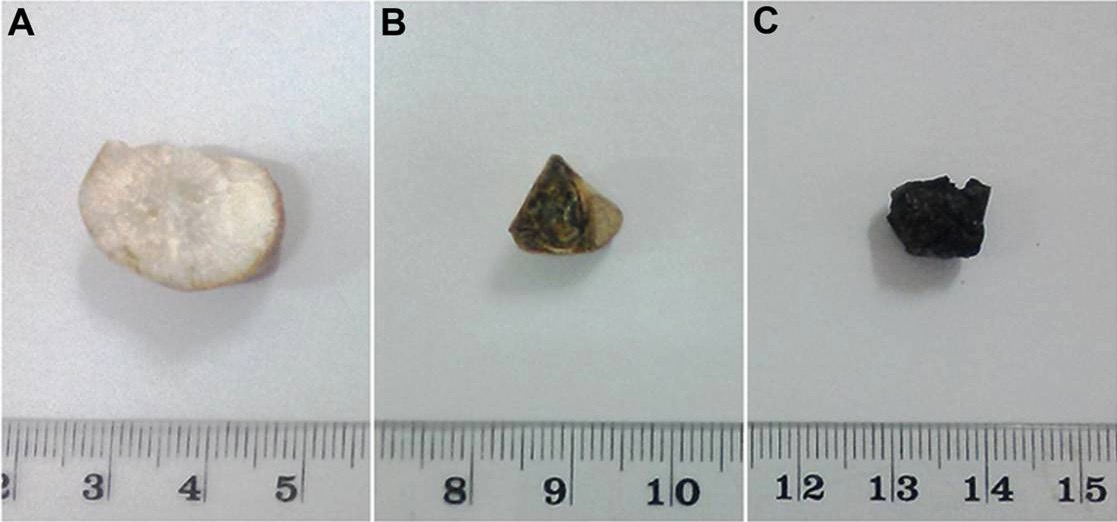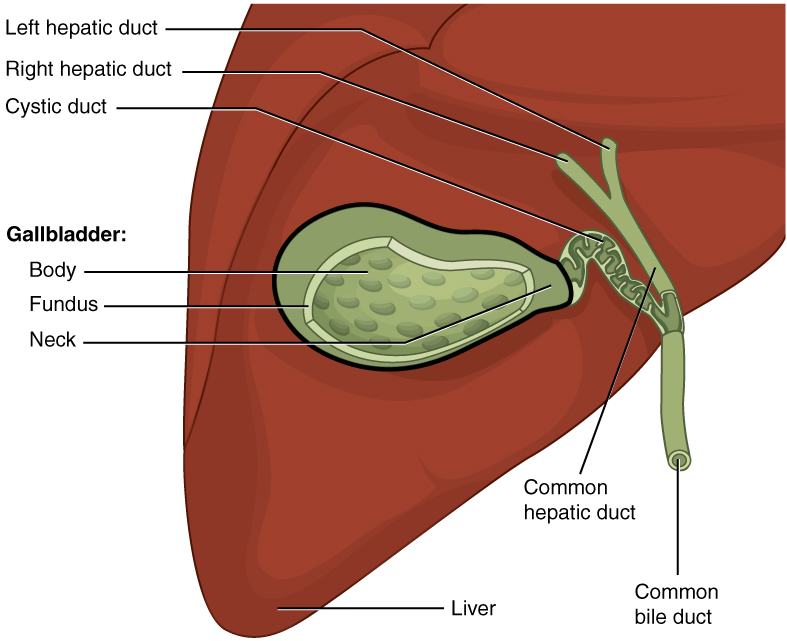Playlist
Show Playlist
Hide Playlist
Gallbladder Abnormalities
-
Slides Gallbladder and Spleen.pdf
-
Download Lecture Overview
00:01 So in this talk, we'll discuss some abnormalities found within the gallbladder, the biliary system, and the spleen. 00:08 Let's review some normal anatomy first. 00:11 It's always important to review the normal anatomy so that it's easier for you to identify what's abnormal. 00:16 So, normal gallbladder and biliary system anatomy on an ultrasound, we can see within the liver, so here's the liver parenchyma right here, you can see this linear hypoechoic areas which represent the bile ducts. 00:29 You can also see that they look very similar to the portal vein within the liver. 00:35 The difference is that the portal vein has an echogenic margin around it and the biliary system does not. So, that's how you differentiate between a bile duct and a portal vein on an ultrasound. 00:46 Here you have a fluid-filled sac which represents the gallbladder. 00:49 Normal common bile duct, the diameter is about 7 mm or so. 00:55 You can see the common bile duct right here, and this is always imaged on an ultrasound because we wanna look for any kind of abnormality within the biliary system which may be represented by the diameter of the bile duct. This can increase in size with age and it can also increase in size after the patient has had a cholecystectomy. 01:13 Let's review some common gallbladder pathology. 01:16 So, the most common finding within a gallbladder is cholelithiasis. 01:20 You also wanna be aware of the findings of acute or chronic cholecystitis and imaging is often performed to evaluate for cholecystitis. 01:28 Choledocholithiasis is another important finding that we'll discuss. 01:33 We'll review what a gallbladder polyp looks like as well, and lastly, we'll go over cholangiocarcinoma, which is something that you really don't wanna miss. 01:41 It's one of the most common malignancies of the biliary system. 01:43 So, cholelithiasis as we said is the most common gallbladder abnormality. 01:48 It's really best assessed on ultrasound. 01:51 Gallstones may or may not be calcified and they may also contain lipid. 01:55 Most gallstones, however, are calcified and often this is found as an incidental finding as patients may be asymptomatic with cholelithiasis. 02:04 So this is an example of an ultrasound image of a patient with cholelithiasis. 02:10 You can see multiple shadowing gallstones that are layering in the dependent portion of the gallbladder and this is very common. It's common for gallstones to be mobile and so they change position with changes in patient positioning. 02:23 When I say shadowing, if you take a look at this behind where the gallstones are, you will see a very dark area, and this is typical of any kind of calcification that's seen on ultrasound. 02:33 It has shadowing and that's how you identify that the area is a calcification. 02:37 So, calcified gallstones will always have this shadowing behind them. 02:42 Acoustical shadowing is really an area of reduced echoes and it's caused because the object or the calcified area reflects most of those echoes, and in this case, the calcified area is the stone. 02:53 So this is an example of a decubitus image. 02:56 The patient is routinely placed into a decubitus position to ensure that all of the stones are mobile and that none of them are impacted within the neck of the gallbladder. 03:05 When a stone does become impacted in the neck, there are more chances that that patient would develop a cholecystitis. 03:10 So, it's important to recognize that. 03:11 On CT, you can see the gallbladder right here and inside of it again are multiple calcified gallstones. 03:22 CT is not really the best way of looking at the gallbladder or gallstones, ultrasound is really the imaging modality of choice. 03:28 However, incidentally we often see gallstones on an abdominal CT and it's something to be aware of and to look for. 03:35 So let's take a look at this image. 03:37 There's an abnormality within the gallbladder. 03:39 What are you seeing here? Can you describe these findings? So, there are multiple low density structures within the gallbladder. 03:56 You can see them right here as I point them out. What are these structures? So, these are actually lipid gallstones. 04:04 Again, most gallstones are calcified. 04:07 However, some may contain lipid and so they are low density on a CT which tells you that these are lipid-containing gallstones. 04:13 Fat, remember, is gonna be low density on a CT. 04:16 If you look at the surrounding subcutaneous fat, the density of the stones actually is very similar to that. 04:22 Here's another case. 04:25 What do you see here? This is again the gallbladder right here. 04:38 What do you see within the gallbladder? So we have echogenic layering debris. 04:43 All of this right here is layering debris. 04:46 However, it's important to recognize that there is no posterior acoustic shadowing like we saw with the calcified gallstones. 04:52 So what could this represent? This is associated with stasis and this is actually gallbladder sludge. 05:00 So this can also impact within the gallbladder and can result in an acute cholecystitis. 05:05 However, it's different from gallstones. 05:06 It's really just a lot of debris that layers within the gallbladder and the one main difference is that sludge does not shadow, and that's how you differentiate between the two. 05:16 So, what are some imaging features of acute cholecystitis? As I mentioned, this is one of the common reasons for performing a right upper quadrant or abdominal ultrasound in a patient that comes in with abdominal pain. 05:27 So, the gallbladder wall will be thickened, it will measure more than 3 mm, there should be pericholecystic fluid, and there should be a positive sonographic Murphy's sign, and so that is pain elicited by compression of the gallbladder with an ultrasound probe. This is similar to a clinical Murphy's sign where the patient has pain in the right upper quadrant upon palpation. 05:47 There may be an impacted stone within the gallbladder neck or within the cystic duct, and again, all of these findings may not be seen. 05:55 These are just some of the imaging features that you may see with an acute cholecystitis. So let's take a look at this case. 06:03 These are ultrasound images of the gallbladder. 06:07 So, what can you see? It's important to also remember that the technologist performing the ultrasound will label all of the images and will do measurements for you, so it's important to take a look at those measurements. 06:19 So you can see here that the gallbladder wall looks a little bit thickened, the normal will be said as 3 mm or less. 06:24 This is again a decubitus image of the gallbladder, and you can see there appears to be a separate fluid collection here. 06:34 This is gallbladder on this side and this is another sagittal decubitus image and we see something within the gallbladder here. 06:42 So, we have a thickened gallbladder wall, we have pericholecystic fluid, and we have gallstones. 06:48 So this is in a case of acute cholecystitis. This patient also had a HIDA scan which demonstrates excretion of radiotracer into the small bowel. 06:58 As you can see here, this is liver right here and then this is radiotracer within the small bowel. 07:04 However, the gallbladder is actually not seen and this was taken about 4 hours after injection of radiotracer. 07:14 So really, if you remember the normal way that the radiotracer is excreted, you actually should be seeing gallbladder pretty simultaneously with small bowel, and when this is not seen, this is again proving that this is an acute cholecystitis. 07:28 So, chronic cholecystitis is slightly different. 07:33 Ultrasound would again demonstrate gallstones and gallbladder wall thickening. 07:37 There would really be no other signs of inflammation noted however. 07:41 The gallbladder is often contracted and often stays in the contracted state, and clinical history is actually very important in excluding an acute cholecystitis because it can be hard to differentiate. 07:51 So, this is an example of a gallbladder polyp. 07:55 This is an echogenic, nonmobile focus within the gallbladder. 07:59 You can see right here it's very small and these are occasionally seen incidentally. 08:03 The key difference between this and a gallstone is again that there is no posterior acoustic shadowing, and this will not change with changes in patient positioning because they're actually attached to the gallbladder wall.
About the Lecture
The lecture Gallbladder Abnormalities by Hetal Verma, MD is from the course Abdominal Radiology.
Included Quiz Questions
Which of the following ultrasound features differentiate a bile duct from a portal vein?
- The portal vein has an echogenic margin that is not seen in a bile duct.
- A bile duct is much larger than a portal vein.
- A bile duct always contains some calcifications while the portal vein lacks calcifications.
- The portal vein has a tortuous course when compared to a bile duct.
- The portal vein is seen only when there is thrombosis in its lumen while a bile duct is seen on a normal ultrasound.
A 44-year-old woman presents to the emergency department with complaints of pain in her abdomen that started an hour after eating lunch. Which of the following is the diagnostic modality of choice in this patient?
- Ultrasound
- CT scan with contrast
- CT scan without contrast
- Nuclear medicine scan
- X-ray
An ultrasound showing a gallbladder that has echogenic layering of debris without acoustical shadowing represents which of the following?
- Gallbladder sludge
- Gall stones
- Porcelain gallbladder
- Cholangiocarcinoma
- Normal finding
Which among the following is NOT a feature of acute cholecystitis?
- Complete white out of the gallbladder
- A thickened gallbladder wall
- Pericholecystic fluid
- A positive Murphy’s sign
- An impacted stone within the gallbladder
Customer reviews
5,0 of 5 stars
| 5 Stars |
|
1 |
| 4 Stars |
|
0 |
| 3 Stars |
|
0 |
| 2 Stars |
|
0 |
| 1 Star |
|
0 |
All of your lectures about radiology are very clear and contain very interesting informations !!! You're one of the best lectors of Lecturio in my humble opinion. Thanks !!






